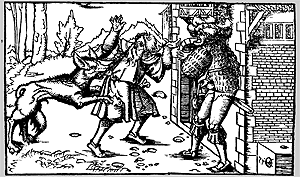 In their book on Norwegian Black Metal "Lords Of Chaos", authors Michael Moynihan and Didrik Søderlind discuss the name Kristian Vikernes took when he had come to resent the Christian connotation of his given name: "Varg". "Varg" means "wolf" in Norwegian.
In their book on Norwegian Black Metal "Lords Of Chaos", authors Michael Moynihan and Didrik Søderlind discuss the name Kristian Vikernes took when he had come to resent the Christian connotation of his given name: "Varg". "Varg" means "wolf" in Norwegian.In Norse mythology the name is associated with werewolves, a superstition based upon"...the existence of a species of madness, during the accesses of which the person afflicted believes himself to be a wild beast, and acts like a wild beast. In some cases this madness amounts apparently to positive possession, and the diabolical acts into which the possessed is impelled are so horrible, that the blood curdles in reading them, and it is impossible to recall them without a shudder".
In various Northern European languages, the word is also used to refer to evil-doers and outlaws, and especially to malefactors guilty of the specific crimes of grave robbery, arson, theft, treason and manslaughter. A ' brennuvargr' (literally 'fire wolf') was the legal term for an arsonist in ancient Norse law.
"The Anglo-Saxons regarded him as an evil man: wearg, a scoundrel; Gothic vargs, a fiend. But very often the word meant no more than an outlaw. Pluquet in his Contes Populaires tells us that the ancient Norman laws said of the criminals condemned to outlawry for certain offences, 'Wargus esto': 'Be an outlaw!'. In like manner the Lex Ripuaria 'Wargus sit, hoe est expulsus'. In the laws of Canute, he is called verevulf. (Leges Canuti, Schmid, i. 148.) And the Salic Law (tit. 57) orders: 'Si quis corpus jam sepultum effoderit, aut expoliaverit, wargus sit'. 'If any one shall have dug up or despoiled an already buried corpse, let him be a varg'."
Moynihan and Søderlind point out that Vikernes is a grave robber, an arsonist a thief, a traitor and a murderer; and that he lives as an outlaw, ostracized from civilized Norwegian society. The authors find it eerie and uncanny that Vikernes would live up to his name so well, "... even down to the subtleties of its earliest etymological essence".
Moynihan and Søderlind do not offer any anthropological or other explanation as to why the most obscure and archaic meanings of the word "Varg" itself would manifest themselves through Vikernes. For such an explanation, I would turn to the work of the anthropologist Victor Turner, and more specifically to his book "Dramas, Fields And Metaphors. Symbolic Action In Human Society".

In an analysis of the Mexican Revolution of Independence of 1810, Turner shows how history repeats the deep myths of a given culture in the form of a social drama. "Myths constitute dramatic or narrative process models which so influence social behaviour that it acquires a strange processual inevitability overriding questions of interest, expediency, or even morality. (...) What seems to happen is that when a major public dramatic process gets under way, people, whether consciously, preconsciously, or unconsciously, take on roles which carry with them, if not precisely recorded scripts, deeply engraved tendencies to act and speak in suprapersonal or 'representative' ways appropriate to the role taken, and to prepare the way for a certain climax that approximates to the nature of the climax given in a central myth of the death or victory of a hero or heroes (...). The (...) myth is here the model, not in a cognitive and bloodless way, but in an existential and bloody way".
It is to be regretted that the sources which are available to me at present do not enable me to ascertain which central myth the climax of the drama of the Black Metal Inner Circle approximates.
Nonetheless, it can be hypothesized that Kristian Vikernes in taking the name "Varg" upon himself, he also took upon himself the role which is associated with that name. Burning churches, desecrating graves, stealing weapons, murdering Øystein "Euronymous" Aarseth and betraying the Norwegian Black Metal community: all these are acts that are appropriate to the name taken and as such are "suprapersonal". The drama which unfolded in the Dream Time of Norwegian Black Metal certainly had a "...strange processual inevitability overriding questions of interest, expediency, or even morality": the drama played out as if it was guided by destiny.
Post scriptum
Here is a link to "The Book Of The Were-Wolves" by Sabine Baring-Gould, published in 1865. The book is quoted in "Lords Of Chaos".




2 comments:
You may know it but Giorgio Agamben's Homo Sacer also has some fascinating remarks on the werewolf and the outlaw. From memory it is something like the one subject to the sovereign ban (at once excluded and marked by the sovereign - 'inclusive exclusion') also becomes positioned as animal. Agamben takes this up again in The Open. This 'choice' of excluded identity also reminds we of Genet's The Thief's Journal.
Thanks Ben! I'm not at all familiar with Agamben's work but after your comment I'm sure I'll investigate ... though I've still got a huge pile of books I have yet to read.
Regarding Genet: I've been thinking about another post on the big bad Varg on the basis of Bataille's remarks on Genet in Literature and Evil - especially the 'cold, glittering' side of Genet/Black Metal...
Post a Comment